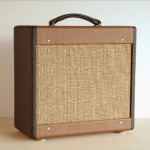Home › Forums › Design and Building › 2 Stroke Amplifier Design and Building › My two stroke saw first light :D
- This topic has 5 replies, 4 voices, and was last updated May 29, 2012 at 9:54 pm by
ToneBone.
-
AuthorPosts
-
May 16, 2012 at 7:06 pm #5133
ToneBone
ParticipantI fired up my completed two stroke build the first time this weekend. after sorting out the 9 pin tube socket issue.
I took all the usual precautions. Rechecked and rechecked. and during my third and final check before power up, On the layout I noticed the wire at the 68k resistor on the positive side of the 8uf.. than runs under the board to the pair of 100k resistors.. for the first time. FaCePalms*
I had no memory of that wire or installing it. Thinking im not that stupid I went a head and turned on the amp and had no sound other than a nearly inaudible hum.. so as a test I rigged a temporary jumper and jumped the 68k to the pair of 100ks and the amp roared to life. after 6 weeks of stairing at this layout I failed to see that connection lol. it really pays to check and re-check everything. anyway the amp sounds great but now im removing the circuit board to install that wire run across the back. But the amp produced no noise and sounded fantastic.Im really happy with my first flirtation in amp building and I would like to thank TAN and everyone here for help making this possible. Thanks!!!!
May 16, 2012 at 8:42 pm #5611Andy
KeymasterCongrats on the first flight!
It really does pay to check everything a few times. When we say to check 3 times, its mostly because we’ve all checked 2 times and then had problems only to find we missed something

On my first build, everything was perfect, except for one, pesky resistor. I has a 220Ω instead of the 220KΩ. It all came down to missing 1 color band. Id like to say thats a rookie mistake but I think I’ve made similar mistakes since
 May 27, 2012 at 4:53 pm #5619
May 27, 2012 at 4:53 pm #5619ampmike
ParticipantYea,The first few amps I built never firedup from the go.I always had to get help.Now I have had the last few work with no issues.It almost scary the moment of truth when you flick that switch.All that work comes down to that moment !Its a rush.I always look for smoke and than sound,Great job.Mike
 May 28, 2012 at 9:29 pm #5620
May 28, 2012 at 9:29 pm #5620Andy
KeymasterI don’t know if we’ve talked about the lightbulb trick, but I always use that on the first fire up. Basically put a lightbulb in the middle of an extension cord. With tubes removed and amp plugged into the extension cord, when it powers up, the lightbulb should stay off. If there is a short in the amp, the lightbulb with glow.
Perhaps not the most elegant trick, but it does bring a tad bit of peace of mind before the first full tube fire up.
May 29, 2012 at 9:33 pm #5621 RobinParticipant
RobinParticipantTo expand on Andy’s comments a little: The light bulb current limiter is an important safety tool when powering up a new (or repaired) amp.
There are several web tutorials on how to build one, check out this link:
http://www.radiomuseum.org/forum/current_limiting_with_a_dim_bulb_tester.html
The switch in this example is nice but the circuit can be built without it (I did not include a switch in mine).The idea behind putting a 100w light bulb in-line with amp circuit is that if there is a dead short in the circuit, the light bulb take the load and prevent the current from blowing the fuse (if you’re lucky) or frying some amp component (usually the power transformer).
When you use the current limiter, the light bulb will light up and then become dim as the circuit stabilizes. If the bulb lights up brightly and stays that way, there is a problem with the amp circuit.
The construction of the current limiter is very simple and inexpensive to assemble (maybe $2.00-3.00), I built mine from stuff already at hand in the garage.
Kendrick amps sells one too. The Kendrick current limiter page gives a good description of what the limiter can be used for. Here is the link:
http://www.kendrick-amplifiers.com/mm5/merchant.mvc?Screen=PROD&Store_Code=KOS&Product_Code=KEN04-limiter&Category_Code=04May 29, 2012 at 9:54 pm #5622ToneBone
ParticipantI did use on old cermic incandescent bulb base I had around. Per my original post, “…I took all the usual precautions…” I consider that a must. but thanks for your reply. I am loving this amp

-
AuthorPosts
- You must be logged in to reply to this topic.
